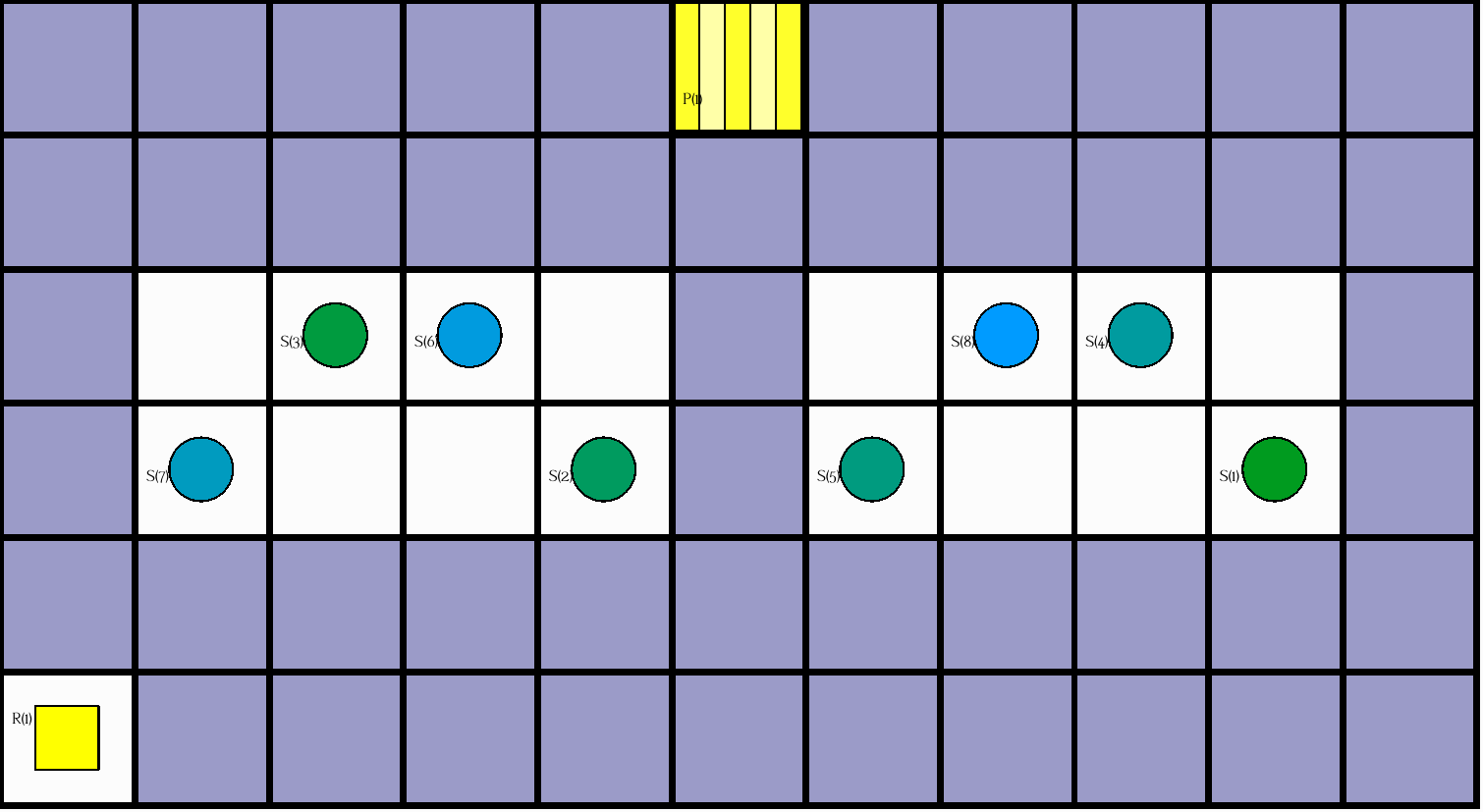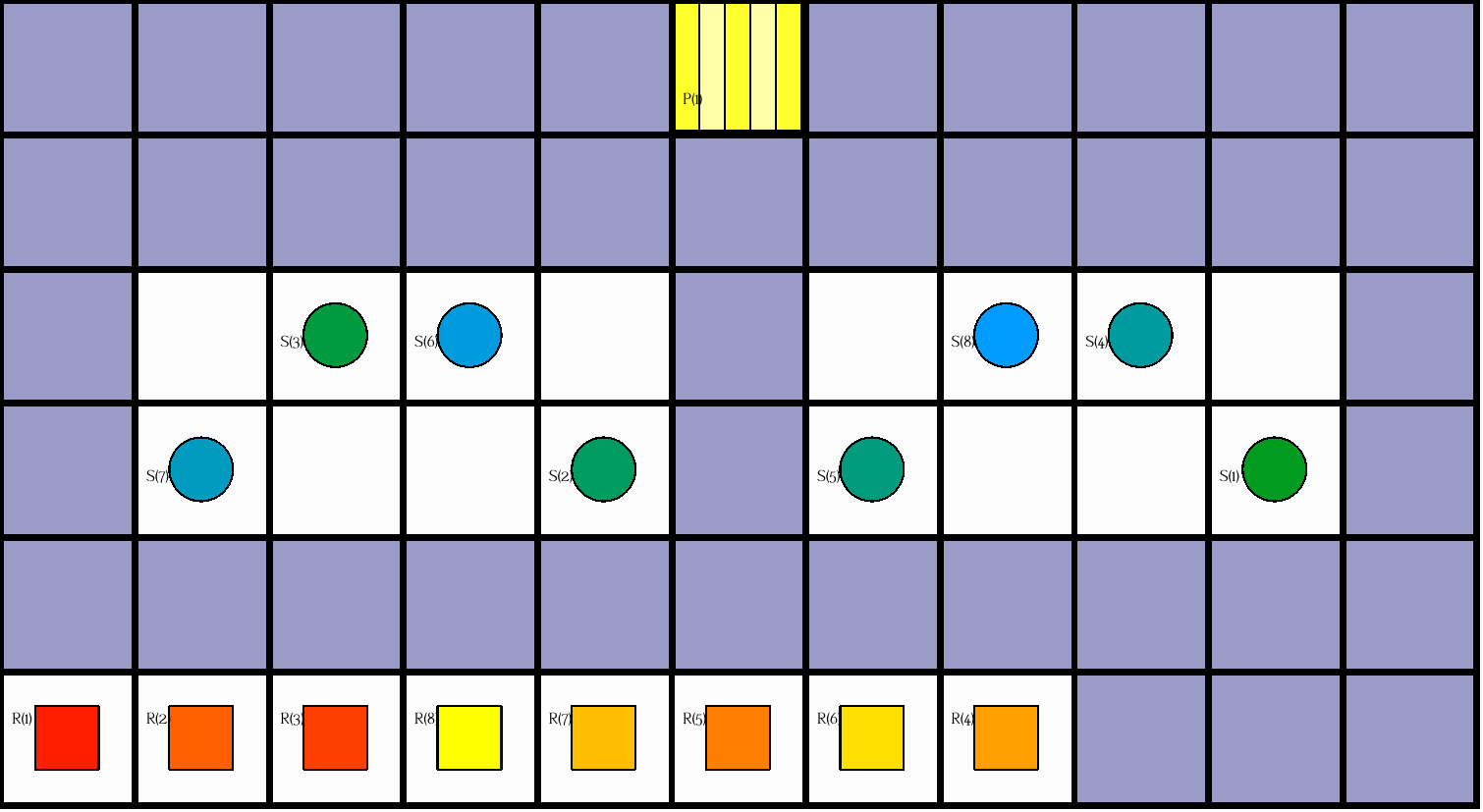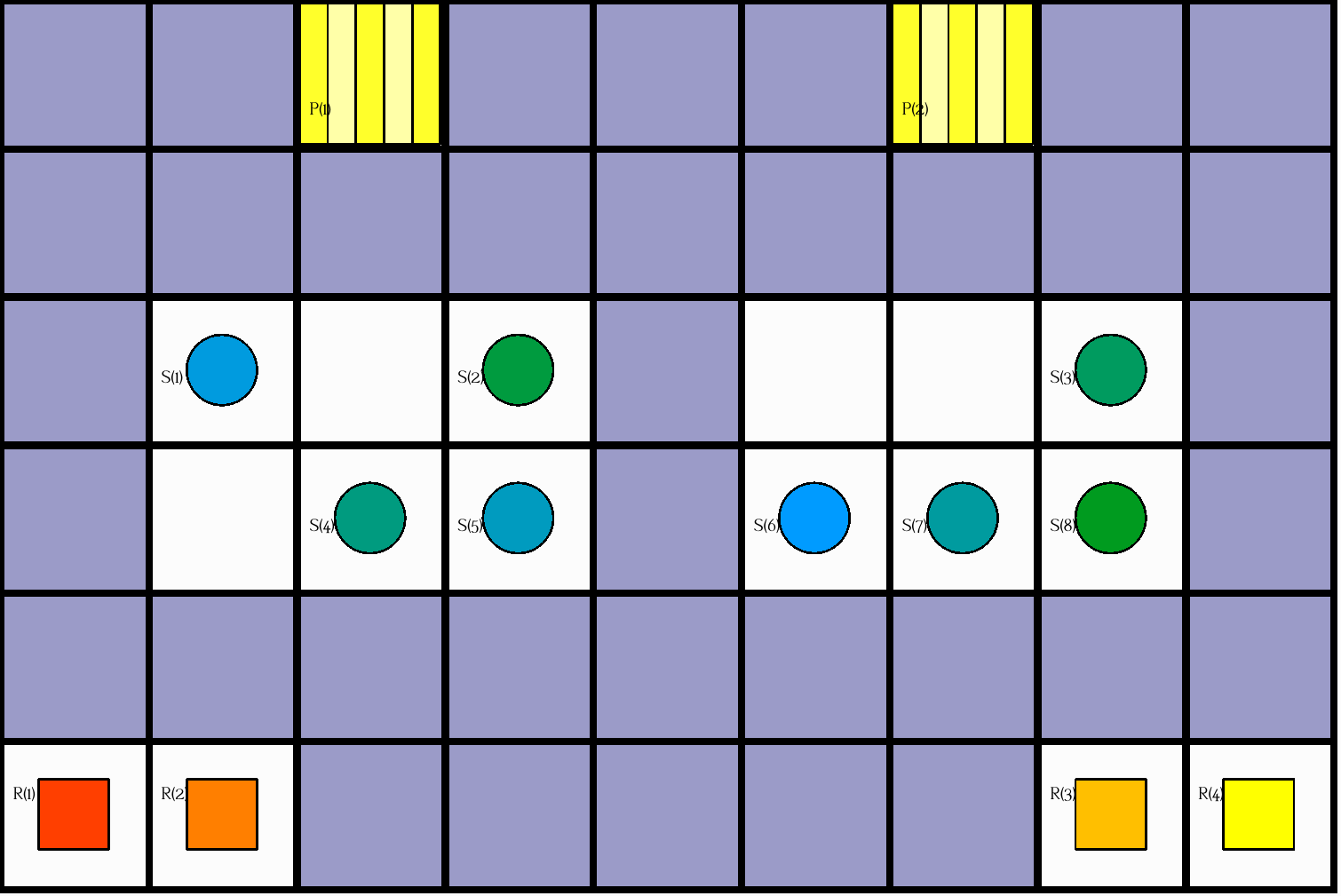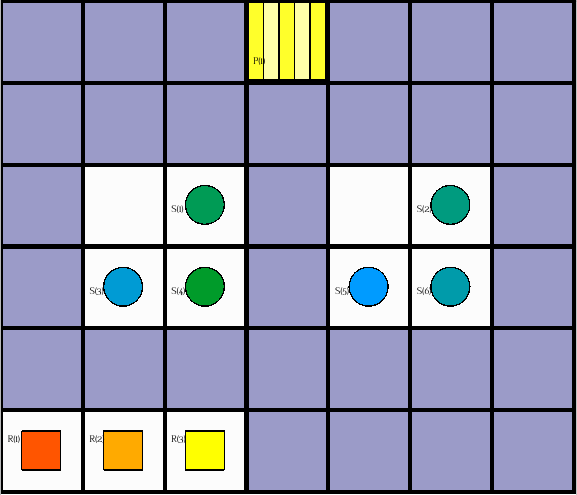This is a collection of seminar exercises for asprilo.
Before addressing the exercises, we strongly recommend you to study
- the asprilo paper
- the asprilo website
- the development branch of our repository on asprilo encodings, esp. the user guide
Important: the subsequent exercises will use the encodings provided by the development branch of asprilo-encodings as foundation.
To run the exercises you have to follow these steps
- Either clone the repository of the asprilo encodings with
git clone https://github.com/potassco/asprilo-encodings.gitand switch to the development branch withgit checkout develop, or download the branch here and uncompress the zip file. - Assign to an environment variable
ENCODINGthe path to the directory of the asprilo encodings. - Either clone this repository with
git clone https://github.com/potassco/asprilo-seminar, or download it here and uncompress the zip file. - Move to the directory of this repository.
- Install the asprilo visualizer following the instructions available in that link.
- To visualize the stable models generated by
clingo, you can redirect its output to a fileoutput.txt(for example, adding> output.txtat the end of theclingocommands below) and then pipe this to the visualizer (for example, withcat output.txt | viz).
For the following objectives, consider structured instances with a single robot in the M-domain such as instance instances/x11_y6_n66_r1_s8_ps1_pr8_u8_o8_N001.lp
Tasks:
-
Relax the goal condition such that all shelves with ordered products can be visited at an arbitrary time point
-
Apply your modifications to the direct encoding, specifically the goal condition: edit the goal condition such that all shelves that contain an ordered product can be visited at an arbitrary point in time (instead of the last time step).
-
Run your modified encoding on instance
instances/x11_y6_n66_r1_s8_ps1_pr8_u8_o8_N001.lpvia
clingo --out-atomf='%s.' -V0 \ -c horizon=15 \ $ENCODINGS/m/{action-M.lp,goal-M-mod.lp,output-M.lp} \ instances/x11_y6_n66_r1_s8_ps1_pr8_u8_o8_N001.lp
where
$ENCODINGSis an environment variable that holds the path to your downloaded (or cloned) development branch of asprilo-encodings$ENCODINGS/m/goal-M-mod.lpis your modified$ENCODINGS/m/goal-M.lpgoal condition encoding
-
-
In addition to the previous modification, extend movement actions to also allow diagonal movement
-
Apply your modifications to the direct encoding, specifically the action theory: edit
direction/1andnextto/3to incorporate diagonal adjacency. -
Run your modified encoding on instance
instances/x11_y6_n66_r1_s8_ps1_pr8_u8_o8_N001.lpvia
clingo --out-atomf='%s.' -V0 \ -c horizon=10 \ $ENCODINGS/m/{action-M-mod.lp,goal-M-mod.lp,output-M.lp} \ instances/x11_y6_n66_r1_s8_ps1_pr8_u8_o8_N001.lp
where
$ENCODINGSis an environment variable that holds the path to your downloaded (or cloned) development branch of asprilo-encodings$ENCODINGS/m/action-M-mod.lpis your modified$ENCODINGS/m/action-M.lpaction theory encoding$ENCODINGS/m/goal-M-mod.lpis your modified$ENCODINGS/m/goal-M.lpgoal condition encoding from the previous exercise
-
For the following objectives, consider structured instances with multiple robot in the M-domain such as instance instances/x11_y6_n66_r8_s8_ps1_pr8_u8_o8_N001.lp
Task: Extend movement actions to also allow diagonal movement and update the collision prevention correspondingly
-
Apply your modifications to the direct encoding, specifically the action theory: prevent edge collisions also for diagonal movements
-
In comparison to Exercise 1.2, we
- also take collision prevention into account, i.e., robots may not cross each other paths while moving diagonally
- but use the regular goal condition of the M-domain
-
Run your modified encoding on instance
instances/x11_y6_n66_r8_s8_ps1_pr8_u8_o8_N001.lpvia
clingo --out-atomf='%s.' -V0 \ -c horizon=20 \ $ENCODINGS/m/{action-M-mod.lp,goal-M.lp,output-M.lp} \ instances/x11_y6_n66_r8_s8_ps1_pr8_u8_o8_N001.lp
where
$ENCODINGSis an environment variable that holds the path to your downloaded (or cloned) development branch of asprilo-encodings$ENCODINGS/m/action-M-mod.lpis your modified$ENCODINGS/m/action-M.lpaction theory encoding
For the following objectives, consider structured instances with multiple robot in the A-domain such as example instance instances/x9_y6_n54_r4_s8_ps2_pr8_u8_o8_N001.lp
Tasks:
-
Limit robots positions exclusively to the left and right half of the warehouse grid
-
Apply your modifications to the direct encoding:
- let mx be the floor of (sx + 1) / 2 where sx is the warehouse grid's x-dimension
- edit the assignment constraints such that all actions of robots with an initial X-position
- smaller or equal than mx are restricted to grid position with x-coordinates <= mx
- otherwise, are restricted to grid position with x-coordinates > mx
- intuitively, robots that are initially placed in the "left half" or "right half" of the warehouse should stay in "left half" or "right half", resp., throughout the whole plan execution.
-
Solution template
#include "../input.lp". % Determine left/right x-coordinates side(X, left) :- SX = #max{ X' : position((X',_)) }, X<=(SX+1)/2, position((X,_)). side(X, right) :- SX = #max{ X' : position((X',_)) }, X> (SX+1)/2, position((X,_)). % Group robots into left/rigth side wrt their initial position ... % Forbid robots to occupy a position on the other side ...
-
Run your modified encoding (including the highway constraints, and with
horizon=25) on instanceinstances/x9_y6_n54_r4_s8_ps2_pr8_u8_o8_N001.lpvia
clingo --out-atomf='%s.' -V0 \ -c horizon=25 \ $ENCODINGS/control/{sides.lp,highways.lp} \ $ENCODINGS/abc/{action-MPP.lp,goal-D-a.lp,output-MPPD.lp} \ instances/x9_y6_n54_r4_s8_ps2_pr8_u8_o8_N001.lp
where
$ENCODINGSis an environment variable that holds the path to your downloaded (or cloned) development branch of asprilo-encodings$ENCODINGS/control/sides.lpis your encoding of the side constraints
-
-
Assign robots to shelves and picking stations on the same side
-
Apply your as assignment constraints to direct encoding, you may use the distance-based assignment constraints as a template
- let mx be the floor of (sx + 1) / 2 where sx is the warehouse grid's x-dimension
- design the assignment constraints such that robots with an initial X-position
- smaller or equal than mx are exclusively assigned to shelves and picking stations with x-coordinates <= mx
- otherwise, are exclusively assigned to shelves and picking stations with x-coordinates > mx
- intuitively, robots that are initially placed in the "left half" or "right half" of the warehouse should interact with shelves and picking stations in the "left half" or "right half", resp., throughout the whole plan execution.
-
Solution template
#include "../input.lp". % Aux predicates to represent products that are ordered and shelved, resp. ordered(order(O),product(A),N) :- init(object(order,O), value(line,(A,N))). shelved(shelf(S),product(A),N) :- init(object(product,A), value(on, (S,N))). % Guess assignments { assign(R,S,P) } :- isRobot(R), isShelf(S), isStation(P). % For each station and product, the assignment must allow for the fulfillment of the sum of % requested quantities by all orders orderedAtStation(A, M, P) :- isProduct(A), isStation(P), M = #sum{ N, O : ordered(O,A,N), target(O,P) }. :- orderedAtStation(A, M, P), #sum{ N,S : assign(_,S,P), shelved(S,A,N) } < M. % Do not assign more than one robot per shelf :- isShelf(S), #count{ R : assign(R,S,_) } > 1. % Determine left/right x-coordinates ... % Group robots, shelve and picking stations into left & right wrt their initial x-coordinates ... % Restrict movement of left/rigth robots to the respective half of the grid ... % Use all robots :- isRobot(R), not assign(R,_,_). % Output #show assign/3. #show init/2.
-
Run your modified encoding (including the highway constraints, and with
horizon=40) on instanceinstances/x9_y6_n54_r4_s8_ps2_pr8_u8_o8_N001.lpvia
clingo --out-atomf='%s.' -V0 \ $ENCODINGS/control/assign-a-sides.lp \ instances/x9_y6_n54_r4_s8_ps2_pr8_u8_o8_N001.lp | \ head -n 1 | \ clingo --out-atomf='%s.' -V0 \ -c horizon=40 \ - \ $ENCODINGS/control/{control-abc.lp,highways.lp} \ $ENCODINGS/abc/{action-MPP.lp,goal-D-a.lp,output-MPPD.lp} \ instances/x9_y6_n54_r4_s8_ps2_pr8_u8_o8_N001.lp
where
$ENCODINGSis an environment variable that holds the path to your downloaded (or cloned) development branch of asprilo-encodings$ENCODINGS/control/assign-a-sides.lpis your modified$ENCODINGS/control/assign-a.lpassignment encoding
-
Task: Expand the regular A-Domain encoding to support energy management:
-
Each robot has an initial battery level
- Input file format:
init(object(robot,Robot_ID),value(energy,Energy_Level)).- E.g.
init(object(robot,2),value(energy,40)).to state that robot 2 has initial energy level 40
- Input file format:
-
Energy consumption per robot action:
- moving
- without carrying a shelf: 1 point
- while carrying a shelf: 2 points
- picking up shelf: 1 point
- putting down shelf 1 point
- delivering : 0 point
- moving
To test and showcase your solution, consider instance instances/x7_y6_n42_r3_s6_ps1_pr12_u24_o3_nrg_N001.lp:
-
In instance
instances/x7_y6_n42_r3_s6_ps1_pr12_u24_o3_nrg_N001.lpwe have the following initial energy levels:init(object(robot,1),value(energy,30)). init(object(robot,2),value(energy,40)). init(object(robot,3),value(energy,50)).
Hence, the workload should be distributed accordingly between the robots.
-
Your energy management encoding may be structured as follows:
% - Input conversion ------------------------------------------------------------------------------- % Map init(object(robot, R), value(energy, E)) to internal representation, % .e.g energy(Robot,EnergyLevel,TimeStep) energy(robot(R),E,0) :- init(object(robot, R), value(energy, E)). % - Energy consumption ----------------------------------------------------------------------------- % *Generalize consumption* % Map different actions to general consumption atoms, e.g. consume(Robot, EnergyAmount, TimeStep) consume(R,1,T) :- move( R, _, T), not carries(R, _,T). ... % *Consumption effect* % For each robot and time step, reflect the effect of its current consumption (via consume/3) % towards its current energy level (via energy/3) ... % *Inertia* % For each robot and time step, if no energy is currently consumed, the energy level % remains unchanged. ... % *Forbid Over-Consumption* % For each robot and time step, the energy level must not be negative. ... % - Output ----------------------------------------------------------------------------------------- #show energy/3.
-
Run your expanded encoding (including the highway constraints, and with
horizon=30) asclingo --out-atomf='%s.' -V0 \ -c horizon=30 \ $ENCODINGS/control/{energy.lp,highways.lp} \ $ENCODINGS/abc/{action-MPP.lp,goal-D-a.lp,output-MPPD.lp} \ instances/x7_y6_n42_r3_s6_ps1_pr12_u24_o3_nrg_N001.lp
where
$ENCODINGSis an environment variable that holds the path to your downloaded (or cloned) development branch of asprilo-encodings$ENCODINGS/control/energy.lpis your energy management encoding
./instances/contains the example instances



